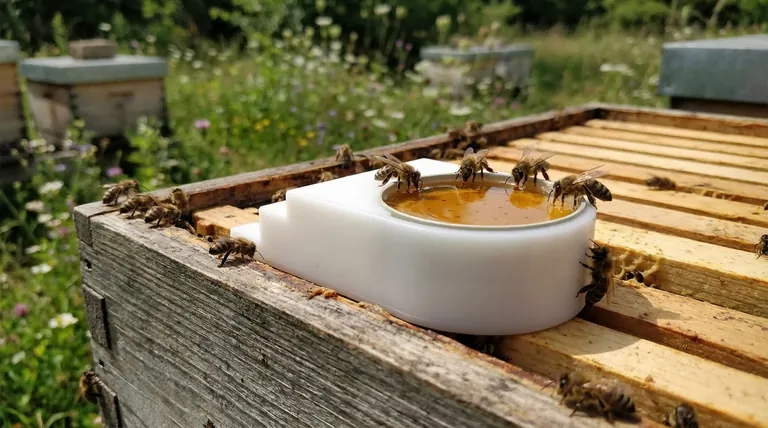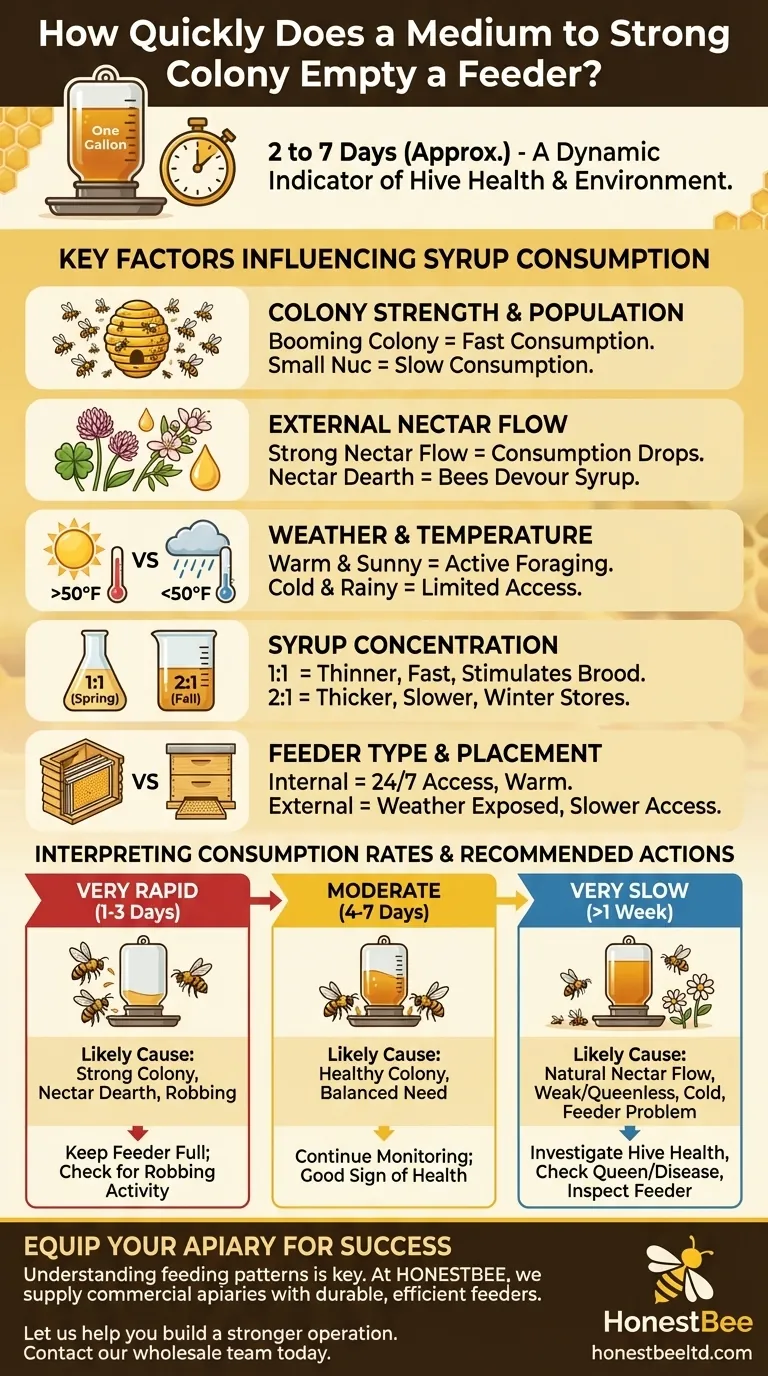As a general rule, a medium to strong honey bee colony will empty a one-gallon feeder in approximately 2 to 7 days. This rate, however, is not a fixed number; it is a dynamic indicator of your colony's health, the surrounding environment, and the time of year.
The speed at which a colony consumes sugar syrup is less of a simple measurement and more of a diagnostic tool. Understanding the factors that influence this rate allows you to accurately assess your hive's needs and the availability of natural resources.

Key Factors Influencing Syrup Consumption
The answer "a matter of days" is a starting point. To truly understand what's happening in your hive, you must consider the variables that dictate the bees' urgency and ability to take down syrup.
Colony Strength and Population
This is the most significant factor. A booming colony with tens of thousands of forager bees and a large brood nest to feed will consume syrup far more rapidly than a smaller or weaker one. A small nucleus colony, or "nuc," might take weeks to empty the same feeder that a powerful production hive drains in 48 hours.
The External Nectar Flow
Bees will almost always prioritize natural nectar over sugar syrup. If a strong nectar flow begins (like a field of clover or a stand of black locust trees blooming), you may see consumption drop to zero almost overnight. This is a good sign, indicating your bees have found a high-quality, natural food source. Conversely, during a nectar dearth (a period with no blooming flowers, common in late summer), bees will descend on a feeder voraciously.
Weather and Temperature
Honey bees are less active in cold, rainy, or windy weather. They may not break their cluster to travel to a top feeder if the temperature inside the hive drops too low. Warm, sunny days encourage foraging behavior and will lead to much faster syrup consumption. Bees require a temperature of at least 50-55°F (10-12°C) for significant activity.
Syrup Concentration (1:1 vs. 2:1)
The type of syrup you offer matters. 1:1 syrup (equal parts sugar and water by weight) mimics natural nectar and is used to stimulate brood rearing and wax production in the spring. Being thinner, it's often consumed very quickly.
2:1 syrup (two parts sugar to one part water) is much thicker and is used to help bees build their essential winter food stores in the fall. It takes more effort for the bees to process and may be consumed more slowly than 1:1 syrup.
Feeder Type and Placement
Accessibility is key. Internal feeders, like frame feeders or top-hive feeders, are located inside the hive's warm, protected environment. Bees can access them 24/7 regardless of the weather.
External feeders, such as entrance feeders, are more exposed to the elements and can be more difficult for bees to access in cool temperatures. They also run a higher risk of attracting ants or robber bees from other colonies.
Interpreting Slow or Rapid Consumption
The rate of consumption is data. A sudden change from the norm warrants investigation. It is your most direct signal of a change in conditions either inside or outside the hive.
Reasons for Very Rapid Consumption (1-3 Days)
- The colony is very strong and is rapidly drawing comb or feeding a massive brood nest.
- There is a complete lack of natural forage (a nectar dearth), and the bees are desperate for carbohydrates.
- The hive is being robbed by bees from another colony, who will steal the syrup at an astonishing rate. Look for frantic, wrestling bees at the entrance.
Reasons for Very Slow Consumption (Over 1 Week)
- The bees have found a superior natural nectar source and are ignoring the feeder.
- The colony may be weak, queenless, or sick, with a low population that cannot consume the syrup.
- The weather is too cold for the bees to access the feeder.
- There is a problem with the syrup or feeder itself. The syrup may have fermented, or dead bees may be blocking access.
Making the Right Choice for Your Goal
Use the feeder speed to guide your beekeeping decisions. Observe, interpret, and then act.
- If the feeder empties in 1-3 days: Your colony is strong and has a significant need for resources. Keep the feeder filled consistently to support their expansion or preparation for winter.
- If the feeder empties in 4-7 days: This suggests a healthy, balanced state. The colony is strong enough to use the support but may also have access to some natural forage.
- If the feeder is barely touched after a week: This is a critical signal to investigate. First, check for a natural nectar flow. If none exists, you must inspect the hive for signs of weakness, disease, or a failing queen.
Ultimately, a feeder is a conversation with your bees, and the speed at which they empty it is their direct response.
Summary Table:
| Consumption Rate | Likely Cause | Recommended Action |
|---|---|---|
| Very Rapid (1-3 days) | Strong colony, nectar dearth, or robbing. | Keep feeder full; check for robbing activity. |
| Moderate (4-7 days) | Healthy colony with balanced need for syrup. | Continue monitoring; a good sign of hive health. |
| Very Slow (Over 1 week) | Natural nectar flow, weak colony, or cold weather. | Investigate hive health; check for a queen or disease. |
Ready to equip your apiary for success?
Understanding your hive's feeding patterns is the first step. The next is ensuring you have the reliable, high-quality equipment needed to support them. At HONESTBEE, we supply commercial apiaries and beekeeping equipment distributors with the durable, efficient feeders and supplies essential for modern beekeeping.
Let us help you build a stronger, more productive operation.
➡️ Contact our wholesale team today to discuss your needs and get a quote on our full range of beekeeping solutions.
Visual Guide

Related Products
- Classic Boardman Entrance Bee Feeder Hive Front Feeding Solution
- Professional Hive Front Entrance Bee Feeder
- Boardman Entrance Bee Feeder Durable Galvanized Steel and Wood Construction for Beekeeping
- HONESTBEE Entrance Bee Feeder Professional Hive Nutrition Solution for Beekeeping
- HONESTBEE Professional Entrance Bee Feeder Hive Nutrition Solution
People Also Ask
- How can a Boardman Feeder be used to provide water to bees? Avoid These Critical Risks to Your Hive
- How is the mesh ladder and barrier installed in the feeder box? A Step-by-Step Guide to Prevent Bee Drowning
- What is the best feeder for bees? Choose the Right Feeder for Your Hive's Success
- Should bees be fed after installing a nucleus hive? Ensure Your New Colony Thrives
- What is a common problem with hive front feeders? Avoid Robbing Frenzies and Protect Your Hives



















